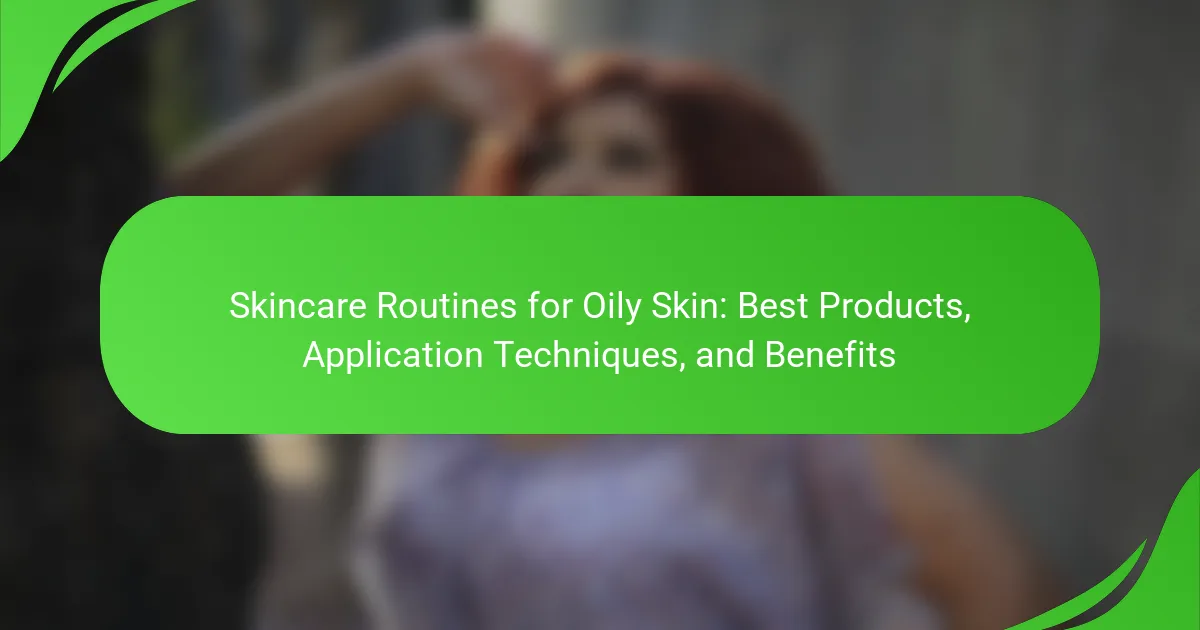Skincare routines for oily skin focus on managing excess oil and preventing breakouts through a series of specific steps. Key components of an effective routine include cleansing with gentle foaming cleansers, toning to balance pH, and using lightweight, oil-free moisturizers and non-comedogenic sunscreens. The article outlines the best products tailored for oily skin, such as gel-based cleansers and oil-free moisturizers, and highlights effective application techniques to enhance absorption and minimize irritation. Regular exfoliation and targeted treatments, including salicylic acid, are emphasized to improve skin health and control shine. Overall, following these guidelines can lead to clearer, healthier skin.

What are Skincare Routines for Oily Skin?
Skincare routines for oily skin typically include specific steps to manage excess oil and prevent breakouts. A basic routine consists of cleansing, toning, moisturizing, and applying sunscreen. Cleansing should be done with a gentle foaming cleanser to remove dirt and oil. Toning helps to balance the skin’s pH and can reduce the appearance of pores. Lightweight, oil-free moisturizers are essential to hydrate without adding excess oil. Sunscreen with a matte finish protects the skin from UV damage while controlling shine. Incorporating exfoliation 1-2 times a week can help remove dead skin cells and prevent clogged pores. Using products with salicylic acid or benzoyl peroxide can also target acne effectively. Following these steps can lead to clearer, healthier skin.
How do skincare routines benefit individuals with oily skin?
Skincare routines benefit individuals with oily skin by controlling excess oil production. Regular cleansing helps remove dirt and impurities that can clog pores. Exfoliation removes dead skin cells, preventing breakouts. Using oil-free moisturizers hydrates the skin without adding extra oil. Incorporating products with salicylic acid can reduce acne and inflammation. These practices lead to a clearer complexion and improved skin texture. Studies show that consistent skincare routines can significantly reduce acne lesions in oily skin types.
What are the common challenges faced by those with oily skin?
Individuals with oily skin commonly face challenges such as excess shine, enlarged pores, and acne. Excess shine occurs due to overproduction of sebum, leading to a greasy appearance. Enlarged pores happen when oil clogs the pores, making them more visible. Acne is prevalent as oily skin can trap dirt and bacteria, resulting in breakouts. Additionally, individuals may experience difficulties with makeup longevity, as products can slide off oily skin. They may also struggle with finding suitable skincare products that effectively control oil without causing irritation. These challenges can lead to frustration and decreased confidence in personal appearance.
How can a proper skincare routine address these challenges?
A proper skincare routine can effectively address challenges associated with oily skin. It helps regulate sebum production, reducing excess oiliness. Cleansing twice daily with a gentle cleanser removes dirt and impurities. Exfoliating weekly prevents clogged pores and breakouts. Using non-comedogenic moisturizers hydrates the skin without adding extra oil. Incorporating products with salicylic acid can help treat acne by penetrating pores. Regular use of clay masks can absorb excess oil and minimize shine. These methods collectively improve skin texture and appearance.
What are the essential components of a skincare routine for oily skin?
The essential components of a skincare routine for oily skin include cleansing, toning, moisturizing, and sun protection. Cleansing should involve a gentle, foaming cleanser that helps remove excess oil without stripping the skin. Toning is important to balance the skin’s pH and reduce the appearance of pores. A lightweight, oil-free moisturizer is crucial to hydrate without adding extra oil. Finally, sun protection with a broad-spectrum SPF is necessary to prevent sun damage and control shine. These components work together to manage oiliness while maintaining skin health.
What types of cleansers are best for oily skin?
Foaming cleansers are best for oily skin. They help remove excess oil and prevent clogged pores. Gel cleansers are also effective, as they provide a deep clean without over-drying. Ingredients like salicylic acid are beneficial. They target acne and control oil production. Clay-based cleansers absorb excess oil and impurities. These types of cleansers promote a clearer complexion. Regular use can lead to improved skin texture.
How do toners contribute to oily skin care?
Toners help manage oily skin by removing excess oil and minimizing pores. They often contain astringent ingredients like witch hazel and salicylic acid. These ingredients effectively reduce oil production. Additionally, toners can balance the skin’s pH after cleansing. This helps prevent the skin from overproducing oil in response to dryness. Some toners also provide hydration without adding excess oil. Studies show that regular use of toners can lead to clearer skin over time. This makes them a beneficial step in oily skin care routines.
What moisturizers are suitable for oily skin types?
Lightweight, oil-free moisturizers are suitable for oily skin types. Gel-based formulas work well because they hydrate without adding excess oil. Ingredients like hyaluronic acid and glycerin provide moisture without clogging pores. Non-comedogenic products are essential to avoid breakouts. Look for moisturizers labeled specifically for oily or acne-prone skin. Brands like Neutrogena, La Roche-Posay, and Clinique offer effective options. These products often contain salicylic acid or niacinamide, which help control oil production. Using the right moisturizer can balance skin hydration and oil levels.
What role do exfoliants play in managing oily skin?
Exfoliants help manage oily skin by removing dead skin cells and excess oil. They prevent clogged pores, which can lead to acne. Regular exfoliation promotes cell turnover, resulting in smoother skin texture. Chemical exfoliants, such as AHAs and BHAs, are particularly effective for oily skin. They penetrate deep into the pores and dissolve oil and debris. Studies show that exfoliation can reduce the frequency of breakouts. For example, a study published in the Journal of Dermatological Treatment found that glycolic acid improved skin clarity in oily skin types. Overall, exfoliants play a crucial role in maintaining clear and healthy skin for those with oily skin.

What are the Best Products for Oily Skin?
The best products for oily skin include gel-based cleansers, oil-free moisturizers, and non-comedogenic sunscreens. Gel-based cleansers effectively remove excess oil without over-drying the skin. Oil-free moisturizers hydrate without adding extra oil. Non-comedogenic sunscreens protect against UV rays without clogging pores. Popular options include Neutrogena Oil-Free Acne Wash, La Roche-Posay Effaclar Mat, and EltaMD UV Clear Broad-Spectrum SPF 46. These products are formulated specifically for oily skin types. They help control shine and prevent breakouts.
How do you choose the right products for oily skin?
To choose the right products for oily skin, prioritize oil-free and non-comedogenic formulations. These products prevent clogged pores and reduce excess oil. Look for ingredients like salicylic acid, which helps control oil and prevents breakouts. Gel-based moisturizers are ideal, as they hydrate without adding extra oil. Incorporate products with niacinamide to balance oil production and minimize shine. Avoid heavy creams that can exacerbate oiliness. Always test new products to ensure they do not irritate the skin. Research indicates that a consistent routine with suitable products can effectively manage oily skin.
What ingredients should be avoided in products for oily skin?
Products for oily skin should avoid ingredients that can exacerbate oiliness. Heavy oils, such as coconut oil and mineral oil, can clog pores. Alcohol-based ingredients can dry out the skin, leading to increased oil production. Silicones may trap dirt and oil, worsening breakouts. Fragrance can irritate sensitive skin and cause inflammation. Comedogenic ingredients, like certain waxes and butters, should also be avoided. These ingredients can lead to acne and other skin issues. Research indicates that non-comedogenic formulations are more suitable for oily skin types.
Which active ingredients are beneficial for oily skin?
Salicylic acid is beneficial for oily skin. It penetrates pores and helps to reduce excess sebum production. This ingredient also has anti-inflammatory properties. It can help prevent acne breakouts. Niacinamide is another effective ingredient. It regulates oil production and improves skin texture. Additionally, it reduces redness and irritation. Clay is also beneficial for oily skin. It absorbs excess oil and impurities. Lastly, tea tree oil has antimicrobial properties. It helps to combat acne-causing bacteria. These active ingredients are widely recognized in dermatology for their efficacy.
What are some recommended products for oily skin?
Recommended products for oily skin include gel-based cleansers, oil-free moisturizers, and clay masks. Gel-based cleansers effectively remove excess oil without over-drying the skin. Oil-free moisturizers provide hydration while preventing clogged pores. Clay masks help absorb excess oil and reduce shine. Popular brands include Neutrogena, La Roche-Posay, and Paula’s Choice. Neutrogena’s Oil-Free Acne Wash is known for its salicylic acid content. La Roche-Posay’s Effaclar Mat is praised for its oil-control properties. Paula’s Choice Skin Perfecting 2% BHA Liquid Exfoliant is effective for minimizing pores. These products are specifically formulated to balance oily skin and prevent breakouts.
What are the top-rated cleansers for oily skin?
The top-rated cleansers for oily skin include gel-based and foaming formulas. These types effectively remove excess oil and impurities without over-drying. Popular options are Neutrogena Oil-Free Acne Wash and CeraVe Foaming [censured] Cleanser. Both products contain salicylic acid, known for its ability to treat acne and clear pores. La Roche-Posay Effaclar Purifying Foaming Gel is another highly rated choice, praised for its gentle formula that maintains skin’s pH balance. Bioderma Sébium Foaming Gel is also recommended, as it targets oily skin while preventing breakouts. These cleansers are frequently recommended by dermatologists for their efficacy in managing oily skin.
Which toners have proven effective for oily skin?
Toners effective for oily skin include those containing witch hazel, salicylic acid, and tea tree oil. Witch hazel helps reduce excess oil and tightens pores. Salicylic acid penetrates pores to prevent acne and reduce oiliness. Tea tree oil has antibacterial properties that help control breakouts. A study published in the Journal of Dermatology found that salicylic acid significantly improved acne symptoms in oily skin types. These ingredients are commonly found in toners specifically formulated for oily skin.
What moisturizers are highly recommended for oily skin types?
Oil-free moisturizers are highly recommended for oily skin types. These products provide hydration without adding excess oil. Gel-based moisturizers are particularly effective. They absorb quickly and leave a matte finish. Ingredients like hyaluronic acid and glycerin are beneficial. They hydrate the skin without clogging pores. Non-comedogenic formulas are also essential. They prevent breakouts while providing moisture. Brands such as Neutrogena, La Roche-Posay, and Clinique offer suitable options. These products are often dermatologically tested for safety and efficacy.
What are the best exfoliants for oily skin?
The best exfoliants for oily skin include salicylic acid, glycolic acid, and enzyme-based exfoliants. Salicylic acid penetrates pores and helps reduce acne by dissolving excess oil. Glycolic acid, an alpha hydroxy acid, promotes cell turnover and improves skin texture. Enzyme-based exfoliants, derived from fruits like papaya and pineapple, gently dissolve dead skin cells without irritation. These exfoliants are effective in managing oily skin, reducing breakouts, and maintaining a clearer complexion. Regular use can lead to improved skin clarity and texture over time.

What Application Techniques are Effective for Oily Skin?
Effective application techniques for oily skin include using lightweight, oil-free products. These products help prevent clogging of pores. Applying products in a gentle, upward motion helps improve absorption. Using a patting technique instead of rubbing minimizes irritation. Layering products from thinnest to thickest ensures proper application. Allow each layer to absorb before applying the next. Regular exfoliation with chemical exfoliants, like salicylic acid, can help manage oil production. Additionally, using a mattifying primer before makeup can control shine throughout the day.
How should products be applied for optimal results?
Products should be applied in a specific order for optimal results. Start with a gentle cleanser to remove excess oil and impurities. Follow with a toner to balance skin pH and prepare it for treatment products. Apply serums next, focusing on lightweight, oil-free formulas that target specific concerns. Use a moisturizer suitable for oily skin to hydrate without clogging pores. Finally, apply sunscreen daily to protect the skin from UV damage. Studies show that following this order enhances product absorption and effectiveness, leading to clearer and healthier skin.
What is the recommended order of application for oily skin products?
The recommended order of application for oily skin products is as follows: cleanse, tone, treat, moisturize, and apply sunscreen. Cleansing removes excess oil and impurities. Toning helps to balance the skin’s pH and minimize pores. Treatment products, like serums or spot treatments, target specific concerns such as acne. Moisturizing is essential, even for oily skin, to maintain hydration. Finally, sunscreen protects the skin from UV damage. This order ensures optimal absorption and effectiveness of each product.
How much product should be used for each step?
For each step in a skincare routine for oily skin, use the following amounts: Cleanser – a dime-sized amount. Toner – 3-5 drops on a cotton pad. Serum – one pump or pea-sized amount. Moisturizer – a nickel-sized amount. Sunscreen – a quarter-sized amount for full coverage. These amounts ensure effective absorption without overloading the skin. Research indicates that using appropriate quantities helps maintain balance and prevents excess oil production.
What techniques can enhance the effectiveness of a skincare routine?
To enhance the effectiveness of a skincare routine, one should incorporate layering products. This technique allows for better absorption of active ingredients. Start with a cleanser to remove impurities. Follow with a toner to balance the skin’s pH. Use serums packed with antioxidants for targeted treatment. Moisturizers help to lock in hydration. Finally, apply sunscreen daily to protect against UV damage. Studies show that consistent application of these steps leads to improved skin texture and clarity.
How does [censured] massage benefit oily skin?
[censured] massage benefits oily skin by improving circulation and reducing excess oil production. Increased blood flow helps nourish skin cells and promote a healthy complexion. This technique also aids in lymphatic drainage, which can reduce puffiness and acne breakouts. Additionally, [censured] massage can enhance product absorption, making skincare products more effective. Studies indicate that regular [censured] massage can lead to a noticeable decrease in sebum production. The technique also helps relax [censured] muscles, contributing to a more balanced skin appearance.
Why is it important to follow a consistent routine?
Following a consistent routine is crucial for achieving effective skincare results. Regular application of products helps maintain skin health and balance. For oily skin, consistency prevents excess oil buildup and reduces breakouts. Studies show that adherence to a routine enhances the efficacy of active ingredients. A 2019 study published in the Journal of Dermatology found that consistent use of skincare products improves skin texture and clarity. Therefore, a structured routine maximizes benefits and supports long-term skin health.

What are the Benefits of a Proper Skincare Routine for Oily Skin?
A proper skincare routine for oily skin helps control excess oil production. It minimizes the appearance of pores, leading to a smoother complexion. Regular cleansing removes dirt and impurities, preventing breakouts. Exfoliation eliminates dead skin cells, promoting cell turnover. Hydration with oil-free moisturizers balances skin moisture without clogging pores. Using non-comedogenic products reduces the risk of acne. Additionally, targeted treatments can address specific concerns like acne and shine. Studies show that consistent routines improve skin health over time.
How does a tailored skincare routine improve skin health?
A tailored skincare routine improves skin health by addressing specific skin concerns and needs. Customized products target issues like oiliness, acne, or dryness. This targeted approach enhances skin balance and reduces irritation. Consistent use of suitable ingredients promotes hydration and nourishment. Studies show that personalized regimens can lead to clearer, healthier skin over time. For instance, a study published in the Journal of Dermatology found that targeted treatments significantly improved acne in participants. By using the right products, individuals can maintain optimal skin function and appearance.
What long-term benefits can be expected from consistent care?
Consistent skincare care for oily skin leads to improved skin texture and reduced oiliness. Regular application of suitable products can minimize the appearance of pores. This routine can also prevent acne breakouts by keeping the skin clean and balanced. Over time, consistent care promotes a healthier complexion and enhances skin hydration. Studies show that maintaining a skincare regimen can result in long-lasting skin health. For instance, a study published in the Journal of Dermatology found that consistent use of non-comedogenic products significantly reduced acne lesions over 12 weeks. Therefore, the long-term benefits of consistent care include a clearer, more balanced, and healthier skin appearance.
How does managing oily skin contribute to overall confidence?
Managing oily skin enhances overall confidence by improving skin appearance and reducing blemishes. Clear and healthy skin is often associated with attractiveness. Individuals with well-managed oily skin may feel more comfortable in social situations. This comfort can lead to increased self-esteem and willingness to engage with others. A study published in the Journal of Cosmetic Dermatology found that individuals with clear skin report higher confidence levels. Additionally, effective skincare routines can lead to a sense of control over one’s appearance. This control fosters a positive self-image and encourages individuals to express themselves freely.
What tips can help maintain a successful skincare routine for oily skin?
To maintain a successful skincare routine for oily skin, use lightweight, oil-free products. These products reduce excess oil without clogging pores. Cleanse your face twice daily with a gentle foaming cleanser. This helps remove impurities and excess sebum. Exfoliate regularly, about 2-3 times a week, to prevent clogged pores. Use a toner with salicylic acid to balance skin and minimize shine. Moisturize daily with a gel-based moisturizer to hydrate without adding oil. Incorporate a clay mask weekly to absorb excess oil and impurities. Lastly, apply sunscreen daily to protect against UV damage without increasing oiliness.
How often should products be replaced or updated?
Products for skincare routines should generally be replaced or updated every 6 to 12 months. This timeframe allows for the effective maintenance of product efficacy and safety. Ingredients in skincare products can degrade over time, especially after opening. For instance, products containing active ingredients like retinol or vitamin C may lose potency after 3 to 6 months. Additionally, products that contain preservatives may have a shelf life indicated on their packaging, guiding users on optimal usage. Regularly assessing the product’s texture, smell, and color can also indicate whether it is still effective.
What lifestyle changes can support oily skin management?
To manage oily skin effectively, implement lifestyle changes that promote balance. Maintain a consistent skincare routine with oil-free products. Incorporate regular cleansing to remove excess oil. Limit the intake of high-glycemic foods, which can trigger oil production. Stay hydrated by drinking plenty of water. Engage in regular physical activity to improve circulation and reduce stress. Avoid touching your face to minimize the transfer of oils and bacteria. Lastly, ensure adequate sleep to support overall skin health. These changes can lead to a noticeable reduction in oiliness and improved skin clarity.
The main entity of the article is “Skincare Routines for Oily Skin.” This article provides a comprehensive overview of effective skincare routines tailored for individuals with oily skin, highlighting essential components such as cleansing, toning, moisturizing, and sun protection. It discusses the benefits of these routines in managing excess oil, preventing breakouts, and improving skin texture. Additionally, the article reviews suitable products, application techniques, and lifestyle changes that support oily skin management, ensuring readers are informed about the best practices and products to achieve clearer, healthier skin.


